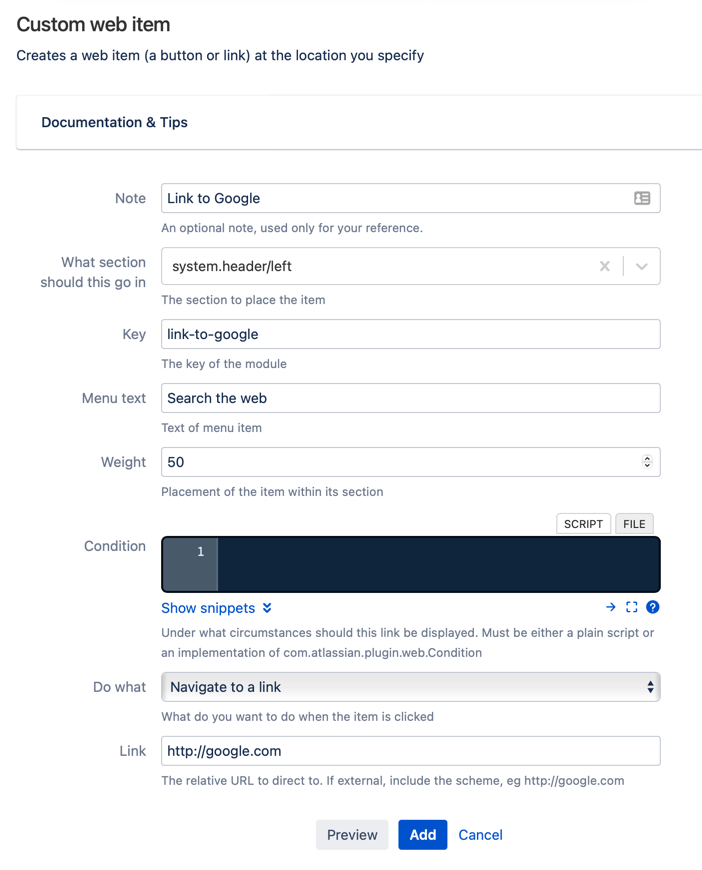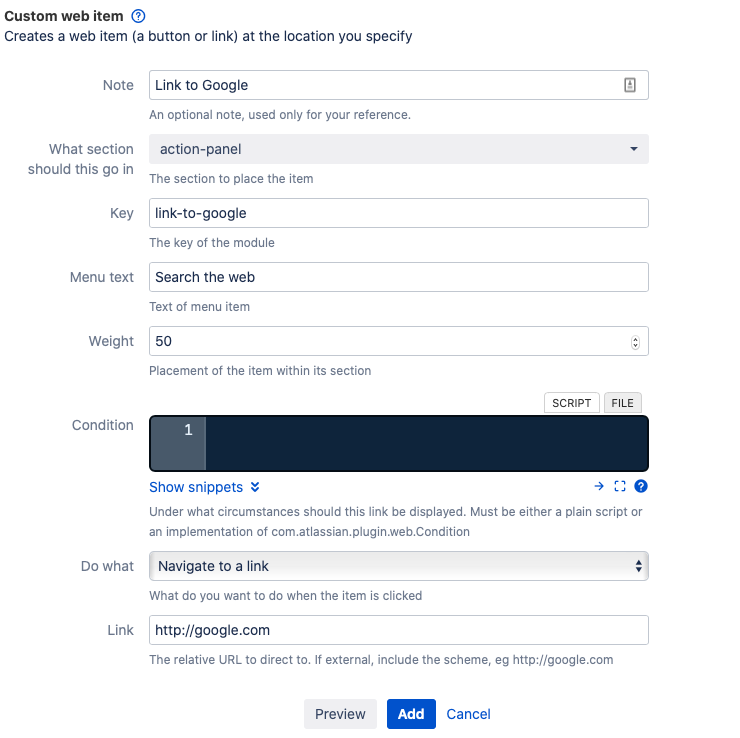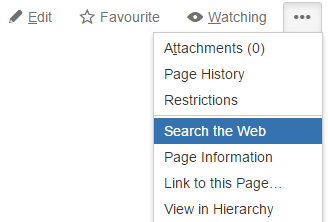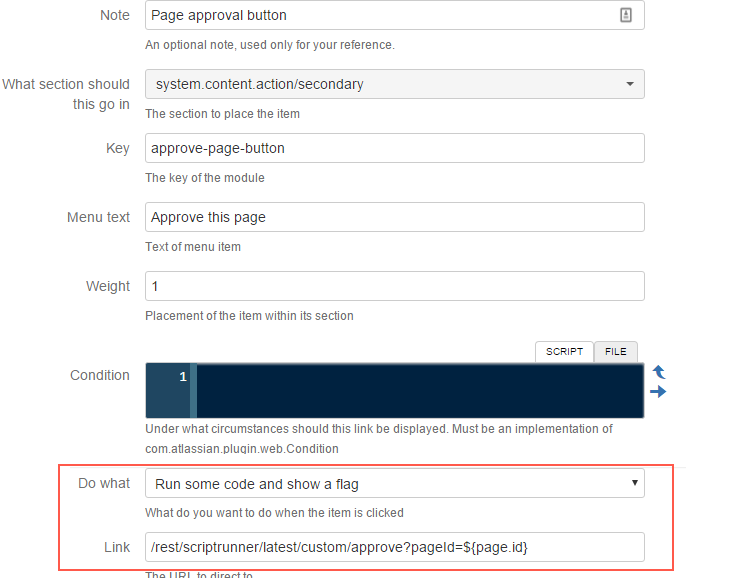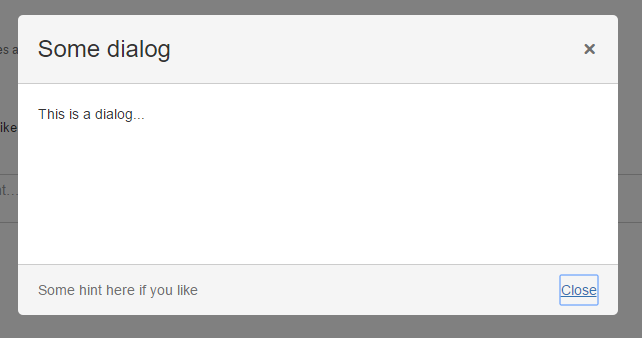Web Item
A web item is a button or link that appears at the location you choose.
Here are some things you can do with web items:
Redirect to another location
Invoke a script endpoint and run code, which can respond with:
A flag
A dialog
A redirection to another page
Examples
Google Link Example
A basic example of a web item is a link to Google at the top of the navigation bar.
Fill out the web item form:
You can understand the Section field’s values by reading the Atlassian web item documentation, or you can use the section finder tool.
The Weight field determines what placement the web item is. If you set it to 1, the link becomes the first item on the left.Click Add to register the fragment.
Go to the dashboard in a new tab, and see your new link.
Click the link to go to Google.
Tools Menu Link
For a more complicated web item, you can add a link to the Confluence wiki pages, which does a Google search on the title of the current page.
Fill out the web item form:
Click Add to register the fragment.
Go to the dashboard in a new tab.
Select this item from the ellipsis menu of any wiki page:
The URL is processed with velocity before rendering. The variables you can use depend on the context of the web item:
They Key needs to be different for each new module you create. If you don’t change the key, the module from the first part of the tutorial is overwritten.
Acting on the Current Page/Issue
You can run code that operates on the current page and returns a message to the user. For example, you could add a property showing approval.
Define a REST Endpoint script, with one endpoint, named
approve.You can use this code:
Bitbucketimport com.onresolve.scriptrunner.runner.rest.common.CustomEndpointDelegate import groovy.json.JsonOutput import groovy.transform.BaseScript import javax.ws.rs.core.MultivaluedMap import javax.ws.rs.core.Response @BaseScript CustomEndpointDelegate delegate approve(httpMethod: "GET") { MultivaluedMap queryParams -> // the details of adding properties or labels to the page, to indicate approval, are ommitted for brevity def pageId = queryParams.getFirst("pageId") as Long // use the pageId to retrieve this page def flag = [ type : 'success', title: "Page approved", close: 'auto', body : "You have signified your approval of this page" ] Response.ok(JsonOutput.toJson(flag)).build() }Verify that this works by browsing to:
http://<confluence-url>/rest/scriptrunner/latest/custom/approve?pageId=12345.It should respond with some JSON.
If you are working with the page, be sure to enter a valid page ID.
Wire this code to an Approve button on the page using a web item.
The form should look like this:
Do What must be set as shown or the flag won’t appear.
Note that the URL is relative to the application base URL, so you don’t need to include the context path if one is set.
The format of the flag is defined in the AUI Flag documentation. Change the Type to return error and warning messages, etc.
Click the Approve button you should see the flag.
As before, experiment with the Weight field to move the menu item up or down.
The problem we have now is that will probably want to limit approving a page to just those in a certain group, or with a certain space permission. We also don’t want to show the menu item if the page has already been approved. You can moderate these with conditions.
Conditions
The Condition field is used to define whether the link should be shown or not, and it can use anything available in its context. What is available in the context depends on the particular web section and the page it is viewed on. Details of the current user can also be used.
For example, if the web item is on a wiki page, you get page and space as conditions. If the web item is on a Space Admin section, then you may only get the space.
The context variable is an instance of WebInterfaceContext. You can use its methods to retrieve the current page.
Example
You can show only the Approve menu item where the current user is a space admin and the current page does not already have the Approved label.
Click the Expand Examples to reveal that there are already two samples that are similar to the two parts to this condition.
Combining the two parts looks like this:
import com.atlassian.confluence.pages.Page import com.atlassian.confluence.security.Permission import com.atlassian.confluence.security.PermissionManager import com.atlassian.confluence.user.ConfluenceUser import com.atlassian.sal.api.component.ComponentLocator import com.atlassian.confluence.spaces.Space def user = context.user as ConfluenceUser def space = context.space as Space def page = context.page as Page if (user && space) { def permissionManager = ComponentLocator.getComponent(PermissionManager) return !page.labels*.name.contains("approved") && permissionManager.hasPermission(user, Permission.ADMINISTER, space) } else { return false }Enter this code in Condition.
It can be entered inline or written to a file underneath a script root.
You should be able to see now that it doesn’t appear for users that are not space admins or when the page is already labelled Approved.
Conditions must be written defensively. What is available in the context or jiraHelper map depends on the particular web section, and the page that it’s viewed on.
For instance, a link in the top section (system.header/left) will not always have the same context variables. When viewed on the dashboard, it may contain just the current user. When you are looking at a page in a space, you will have a reference to the current page object. Therefore, check that context variables are not null before calling methods or properties on them.
If you are using a section like system.content.action, you can assume you will always have the page context variable defined.
In addition to using a script, you can use a concrete class that implements conditions, which extends the existing condition.
Dialogs (Advanced)
You can show some dialogs. For complex interactions, you need to write javascript.
To display a dialog when the user clicks a web item, select the Run Code and Display a Dialog option. The endpoint needs to return HTML for an AUI dialog2. The following REST endpoint code displays a dialog when clicked:
import com.onresolve.scriptrunner.runner.rest.common.CustomEndpointDelegate
import groovy.transform.BaseScript
import javax.ws.rs.core.MediaType
import javax.ws.rs.core.MultivaluedMap
import javax.ws.rs.core.Response
@BaseScript CustomEndpointDelegate delegate
showDialog { MultivaluedMap queryParams ->
// get a reference to the current page...
// def page = getPage(queryParams)
def dialog =
"""<section role="dialog" id="sr-dialog" class="aui-layer aui-dialog2 aui-dialog2-medium" aria-hidden="true" data-aui-remove-on-hide="true">
<header class="aui-dialog2-header">
<h2 class="aui-dialog2-header-main">Some dialog</h2>
<a class="aui-dialog2-header-close">
<span class="aui-icon aui-icon-small aui-iconfont-close-dialog">Close</span>
</a>
</header>
<div class="aui-dialog2-content">
<p>This is a dialog...</p>
</div>
<footer class="aui-dialog2-footer">
<div class="aui-dialog2-footer-actions">
<button id="dialog-close-button" class="aui-button aui-button-link">Close</button>
</div>
<div class="aui-dialog2-footer-hint">Some hint here if you like</div>
</footer>
</section>
"""
Response.ok().type(MediaType.TEXT_HTML).entity(dialog.toString()).build()
}The button with the ID dialog-close-button will be automatically wired to close when clicked if you use a dialog ID of sr-dialog.
If you require more complex interactions you should require some javascript and wire the elements, for example:
(function ($) {
$(function () {
AJS.dialog2.on("show", function (e) {
var targetId = e.target.id;
if (targetId == "my-own-dialog") {
var someDialog = AJS.dialog2(e.target);
$(e.target).find("#dialog-close-button").click(function (e) {
e.preventDefault();
someDialog.hide();
someDialog.remove();
});
// etc
}
});
});
})(AJS.$);Removing the dialog from the DOM when the dialog is hidden (for example, when pressing the ESC key) is controlled by the data-aui-remove-on-hide attribute.
Removing this attribute hides the dialog rather than remove it when the dialog is hidden.
In this case, handle re-showing the dialog in your JavaScript code. The web item trigger re-renders a completely new dialog for you.
You can include your additional dialog with a web resource fragment.
When you click the link, the dialog appears:
Redirects
Return a redirect to run code and then redirect to another page, or load the same page after updating it.
The following example adds a label to the current page/issue and then refreshes it by redirecting to the same page:
import com.atlassian.confluence.labels.Label
import com.atlassian.confluence.labels.LabelManager
import com.atlassian.confluence.labels.Labelable
import com.atlassian.confluence.labels.Namespace
import com.atlassian.confluence.pages.PageManager
import com.atlassian.sal.api.ApplicationProperties
import com.atlassian.sal.api.component.ComponentLocator
import com.onresolve.scriptrunner.runner.rest.common.CustomEndpointDelegate
import groovy.transform.BaseScript
import javax.ws.rs.core.MultivaluedMap
import javax.ws.rs.core.Response
@BaseScript CustomEndpointDelegate delegate
def labelManager = ComponentLocator.getComponent(LabelManager)
def pageManager = ComponentLocator.getComponent(PageManager)
def applicationProperties = ComponentLocator.getComponent(ApplicationProperties)
labelPage(httpMethod: "GET") { MultivaluedMap queryParams ->
def pageId = queryParams.getFirst("pageId") as Long
def page = pageManager.getPage(pageId)
def label = labelManager.getLabel("approved")
if (!label) {
label = labelManager.createLabel(new Label("approved", Namespace.GLOBAL))
}
labelManager.addLabel(page as Labelable, label)
Response.temporaryRedirect(URI.create("${applicationProperties.baseUrl}/pages/viewpage.action?pageId=${pageId}")).build()
}Make sure to select Navigate to a Link as the intention setting.
Further examples
Display a message if a page is publicly visible ( Atlassian Answers)
Show recent projects from a particular project category ( Atlassian Answers )


